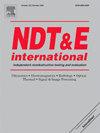结构导向的单向激励和瑞利波接收压电换能器
IF 4.1
2区 材料科学
Q1 MATERIALS SCIENCE, CHARACTERIZATION & TESTING
引用次数: 0
摘要
瑞利波对厚壁结构的无损检测至关重要。瑞利波的单向传播通过减少不必要的反射来简化信号解释。基于斯涅尔定律的楔形换能器通常产生单向瑞利波。然而,由于楔形和波导之间的波阻抗差很大,在界面处存在传输损耗。本文提出了一种结构引导换能器(SGT),用于单向激励和接收瑞利波。SGT由楔形衬底和厚度剪切压电片组成。基板采用与瑞利波钢结构阻抗匹配的铁磁材料制成。衬底有利于导波的自动控制,保证了SGT的单向能力。在理论设计之后,通过有限元模拟和实验对SGT的性能进行了评估。结果证实产生了单向度约为13 dB的纯瑞利波。此外,SGT还可以作为一个传感器,选择性地捕获来自特定方向的瑞利波,有效地过滤掉来自其他方向的波。SGT的设计既直接又有利于制造。它可以防止由于楔形与测试结构之间的阻抗不匹配而导致的能量损失。此外,SGT的磁性基板可以轻松地附着在钢结构上,从而简化了安装和重新定位。凭借这些优势,SGT极有可能在无损检测中具有巨大的应用潜力。本文章由计算机程序翻译,如有差异,请以英文原文为准。

Structure-guided piezoelectric transducer for unidirectional excitation and reception of Rayleigh waves
Rayleigh waves are crucial for nondestructive testing (NDT) of thick-walled structures. Unidirectional propagation of Rayleigh waves simplifies signal interpretation by minimizing unwanted reflections. Unidirectional Rayleigh waves are commonly generated using wedge transducers based on Snell's law. However, due to the large wave impedance difference between the wedge and the waveguide, there is a transmission loss at the interface. This work proposed a structure-guided transducer (SGT) for unidirectional excitation and reception of Rayleigh waves. The SGT consists of a wedge-shaped substrate and thickness-shear piezoelectric wafer. The substrate is fabricated using ferromagnetic material, which is impedance-matched to the steel structure for Rayleigh waves. The substrate facilitates the automatic control of the guided waves, guaranteeing the unidirectional capabilities of the SGT. Subsequent to the theoretical design, the performance of the SGT was assessed via finite element simulations and experiments. Results confirmed the generation of pure Rayleigh waves with a unidirectionality of approximately 13 dB. Moreover, the SGT can also act as a sensor to selectively capture Rayleigh waves from a specific direction, efficiently filtering out waves from other directions. The design of the SGT is both straightforward and conducive to manufacturing. It can prevent energy loss resulting from impedance mismatches between the wedge and the test structure. Additionally, the magnetic substrate of the SGT facilitates effortless attachment to steel structures, thereby simplifying installation and relocation. With these advantages, the SGT is highly likely to have substantial potential for applications in NDT.
求助全文
通过发布文献求助,成功后即可免费获取论文全文。
去求助
来源期刊

Ndt & E International
工程技术-材料科学:表征与测试
CiteScore
7.20
自引率
9.50%
发文量
121
审稿时长
55 days
期刊介绍:
NDT&E international publishes peer-reviewed results of original research and development in all categories of the fields of nondestructive testing and evaluation including ultrasonics, electromagnetics, radiography, optical and thermal methods. In addition to traditional NDE topics, the emerging technology area of inspection of civil structures and materials is also emphasized. The journal publishes original papers on research and development of new inspection techniques and methods, as well as on novel and innovative applications of established methods. Papers on NDE sensors and their applications both for inspection and process control, as well as papers describing novel NDE systems for structural health monitoring and their performance in industrial settings are also considered. Other regular features include international news, new equipment and a calendar of forthcoming worldwide meetings. This journal is listed in Current Contents.
 求助内容:
求助内容: 应助结果提醒方式:
应助结果提醒方式:


